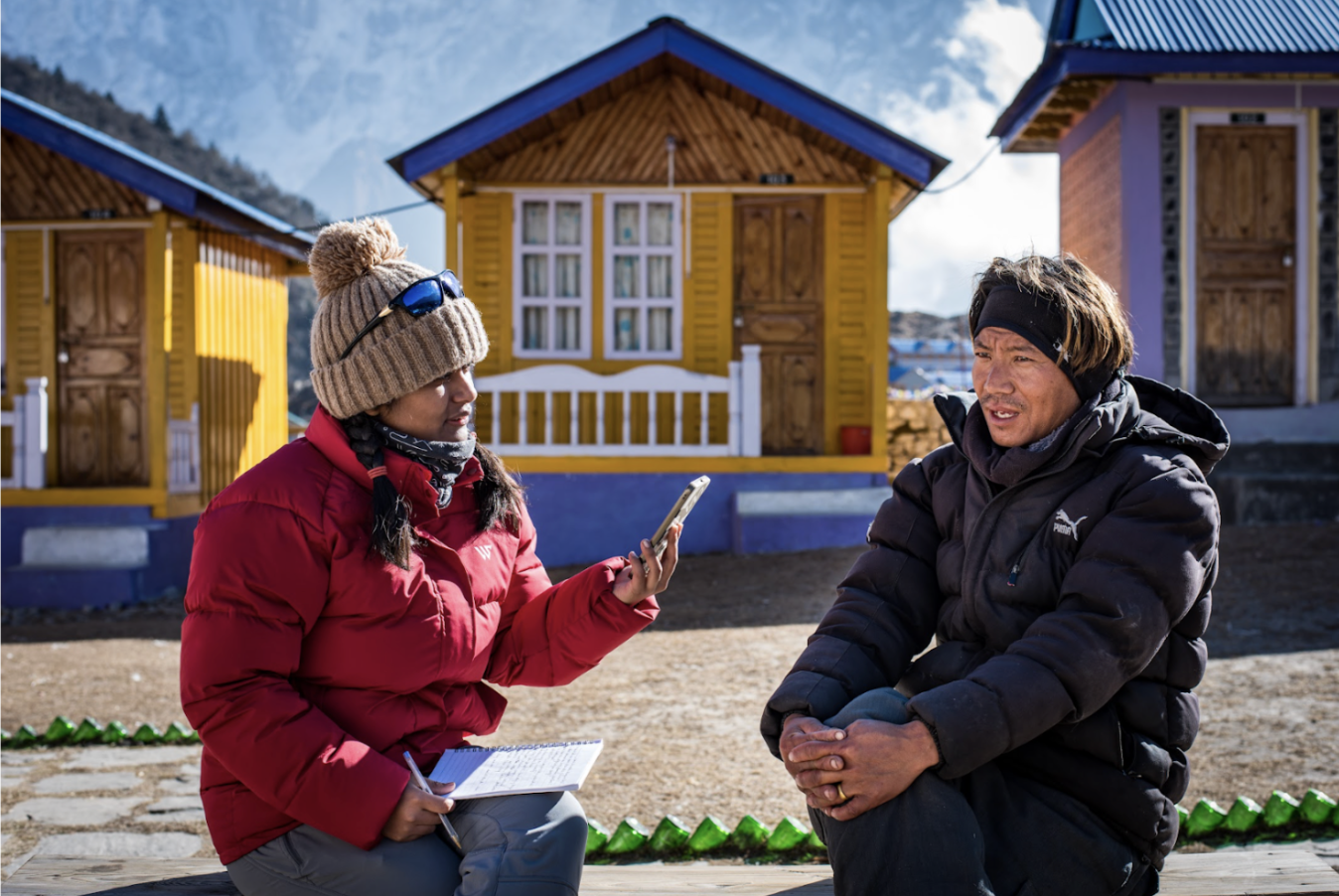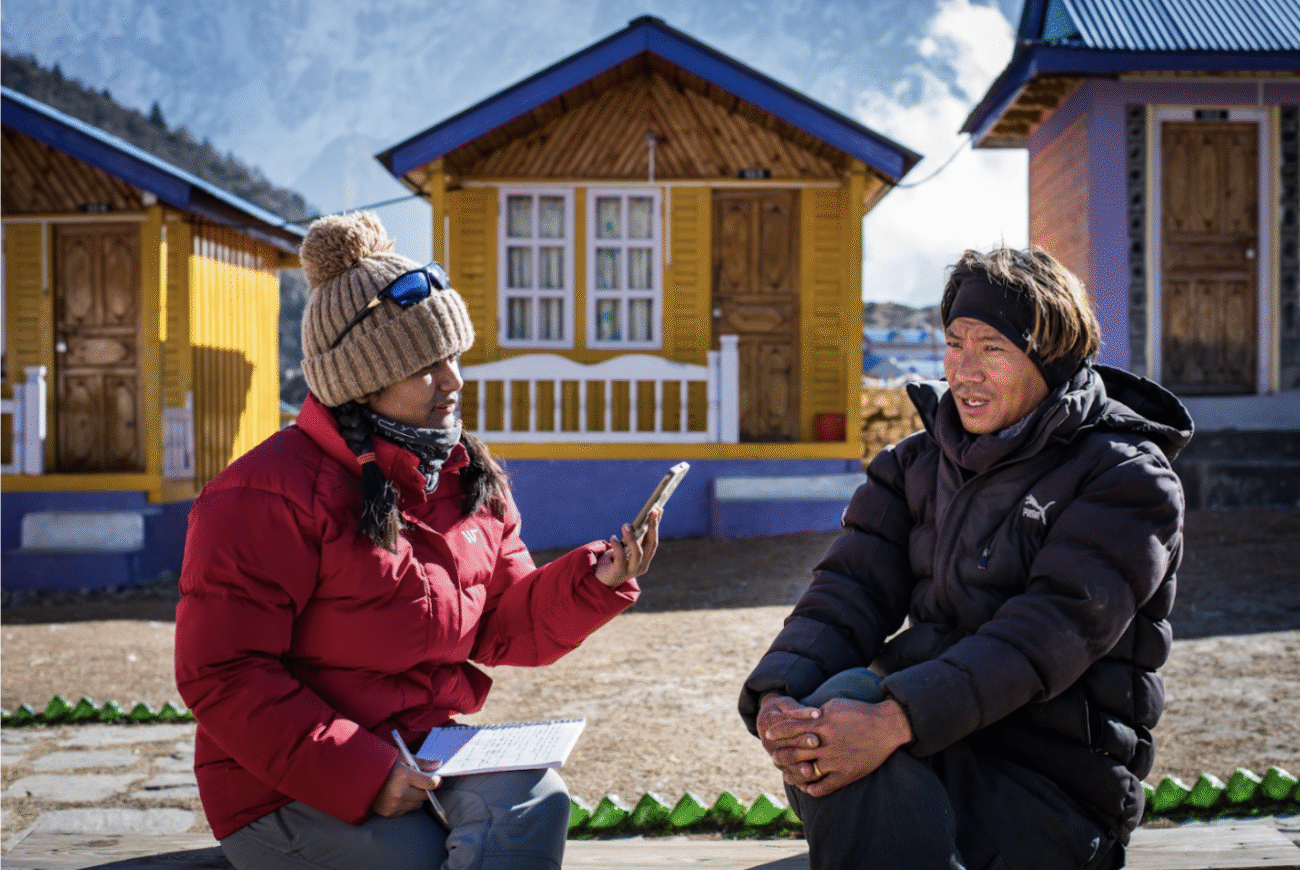One chilly morning this past December, nine women awoke to the sight of a glacier looming before them, glowing orange in the rising sun. These scientists had spent their lives studying the cryosphere—the frozen part of the Earth—but most had never encountered it in person.
The members of this group were selected as the first cohort of the Hindu Kush Himalaya HKH Women on Ice expedition, an initiative recently launched by the International Center for Integrated Mountain Development (ICIMOD). ICIMOD is a Nepal-based NGO focused on the conservation and sustainability of mountain regions in Asia. For this expedition, women from five countries traveled to the Ponkar Glacier in the Gandaki River basin in Nepal.
There are an estimated 54,000 glaciers in the Hindu Kush Himalaya, covering 60,000 square kilometers and serving as a vital source of freshwater for the region’s rivers. Now, these glaciers are shrinking substantially due to climate change. The Women on Ice team set out to explore the impacts of climate change on the Ponkar glacier, which has a terminus at 3,651 meters (11,978 feet) and is one of the most massive glaciers in the area.
Guided by cryosphere experts with extensive field experience, the participants conducted interdisciplinary fieldwork projects to learn about the glacial features and surrounding human communities.
The inspiration: bringing more women into cryosphere science
Cryosphere science has been a historically male-dominated discipline. In the 1980s, when senior ICIMOD scientist Miriam Jackson began her glacier research in England, women were not permitted to go to Antarctica through the British program.
In 1987, Jackson managed to land a spot on an expedition to Greenland through Ohio State University, where she was the only woman in a group of 10. “There was definitely a gender—and also a bit of a power—imbalance,” Jackson told GlacierHub.
Robin Bell, a lecturer at Columbia’s Lamont-Doherty Earth Observatory and former president of the American Geophysical Union, had a similar experience on a research trip in 1989.
When the opportunity came for Bell to work in Antarctica, she grabbed it, and became the only female principal investigator at McMurdo, which operates year-round and is the largest U.S. station on the continent. The following year, Bell brought two more women for the journey, a student and a technician.
Since then, Bell has prioritized inclusive science in her work. “I’ve worked on trying to make science open for everybody,” said Bell. “Sometimes we don’t think about bringing everyone along, but the understanding is that our science is better with more people at the table.”
Bell also emphasized the power of inclusivity more generally. “Research shows that more diverse groups make better decisions,” she said.
Despite some concerted global efforts to invite women into glacier science, such as Girls on Ice and Adventure of Science, Jackson noted the gender imbalance she and Bell experienced in the 1980s remains prevalent, particularly in Asia. There, many women engage in office-based work like glacier modeling and remote sensing, but rarely conduct fieldwork.
The Hindu Kush Himalaya Women on Ice expedition aimed to change this. “We wanted to capacitate these women so that they go back to the community and lead the community as well,” said expedition organizer Sunwi Maskey, a cryosphere research associate at ICIMOD.
The final team comprised nine women, ranging from undergraduate to postdoctoral students, spanning disciplines from geosciences to international relations, and coming from Bhutan, India, Nepal, Pakistan and China.

Walking on ice: preparations and challenges
“The preparation started the day we announced the participants,” said Maskey. Long before meeting in person, the leaders conducted virtual meetings so participants could get to know each other and learn how to prepare, physically and mentally. On December 4, after months of preparation, the team piled into jeeps in Kathmandu and departed for the glacier.
Despite the cultural, religious and disciplinary differences between them, the participants bonded quickly. Aishwarya Sanas, who is currently earning her Ph.D. in international relations and governance studies at Shiv Nadar University in India, had originally worried that she would be the “odd one out” as the only participant not studying the natural or physical sciences. Meeting in person a few days before the journey, however, quenched her anxiety. “The way in which everyone just came together and helped each other out is what stood out,” Sanas said. “The team dynamics were incredible.”
Additionally, facing high altitudes and steep terrain encouraged strong collaboration among the participants, many of whom struggled with the altitude and extreme weather conditions despite rigorous pre-journey preparations. Silian Pan, a Ph.D. student in Germany at Leibniz University specializing in Arctic permafrost microbiology, recalls a day when she walked for 10.5 hours, arriving at the campsite late at night in minus 18 degree Celsius weather. “I suffered a lot,” she said.
Still, for Pan, seeing the peak and the glaciers made the pain worthwhile. “When you see the picture from 10 or 20 years ago, and how the mountain looked, and you compare them, you find the meaning of your work; it has changed a lot,” she explained.
The region’s aesthetic beauty and recreational opportunities were another source of motivation for the participants. Remote sensing and geo-information analyst Finu Shrestha said, “Every day was beautiful. The mountains are so close that you can’t keep your eyes off of them.”
Tuba Farooq, a Pakistani participant who recently completed her MPhil degree in environmental science from the University of Engineering and Technology in Lahore, found fulfillment in connecting with her companions past the level of being research associates. “At night, when we came back from trekking, we played a lot of games. Sometimes we danced as well. That was the best part,” said Farooq.
For Sanas, an important takeaway was that glacial science is intricately connected to one’s physical readiness and mental capacity to do the work. “You have to look after your health,” she explained, “and at the end of this, [with] whatever life you have left in you, you do your research.”

Sharing knowledge: research and lessons
As it turns out, the participants had plenty of life left in them to conduct research throughout the journey. They were divided into three group focus areas: glaciers, permafrost, and social and economic factors.
Sanas participated in the third group, interviewing porters, guides, mountaineers and locals. She learned that many locals want a road to ease the process of transporting the goods that tourists demand. For example, Sanas explained, “The tourists want coffee. The locals don’t consume coffee. It’s not part of the culture.”
After completing her project, Sanas recommended that villagers come together to form what she termed a “code of conduct” between themselves and the tourists to encourage respect and sustainability. For Pan, recognizing the impacts of climate change on the region reminded her of the importance of the research. “Now, the glacier lake is gone, the water there is very small,” she explained. “The local people… need to walk 30 minutes to get the water for daily use. That’s why we study this.”
Another unusual aspect of the expedition was the employment of female porters. Shrestha explained that female porters are rare, because they typically cannot bear the same physical load as men. Pan learned through interviewing these porters that many were housewives for whom carrying baggage is one of the only ways to generate income. She explained, “They want to hike. A lot of people like hiking, but they don’t have the chance; it’s too expensive for them. They cannot come as a tourist, [but] as a worker, they can.”
The experience transformed how participants will conduct research going forward. “When you go into the field, there are so many other things that come into life,” Farooq explained.
Before the expedition, Farooq had not travelled to another city, let alone another country, without her family. She advised other women to take advantage of such opportunities when they arise. “Be courageous,” she said. “Whatever opportunity you have, you should avail yourself of that.”

Farooq also noted the importance of having a diverse group. “We were all looking at the same picture, but from different angles,” she said.
The initiative’s leaders hope to run the program again in coming years. They have already begun brainstorming for the next expedition, continuing to chip away at the “ice ceiling” and toward inclusion and greater opportunities for women in the cryosphere sciences.
Source link
Guest news.climate.columbia.edu

